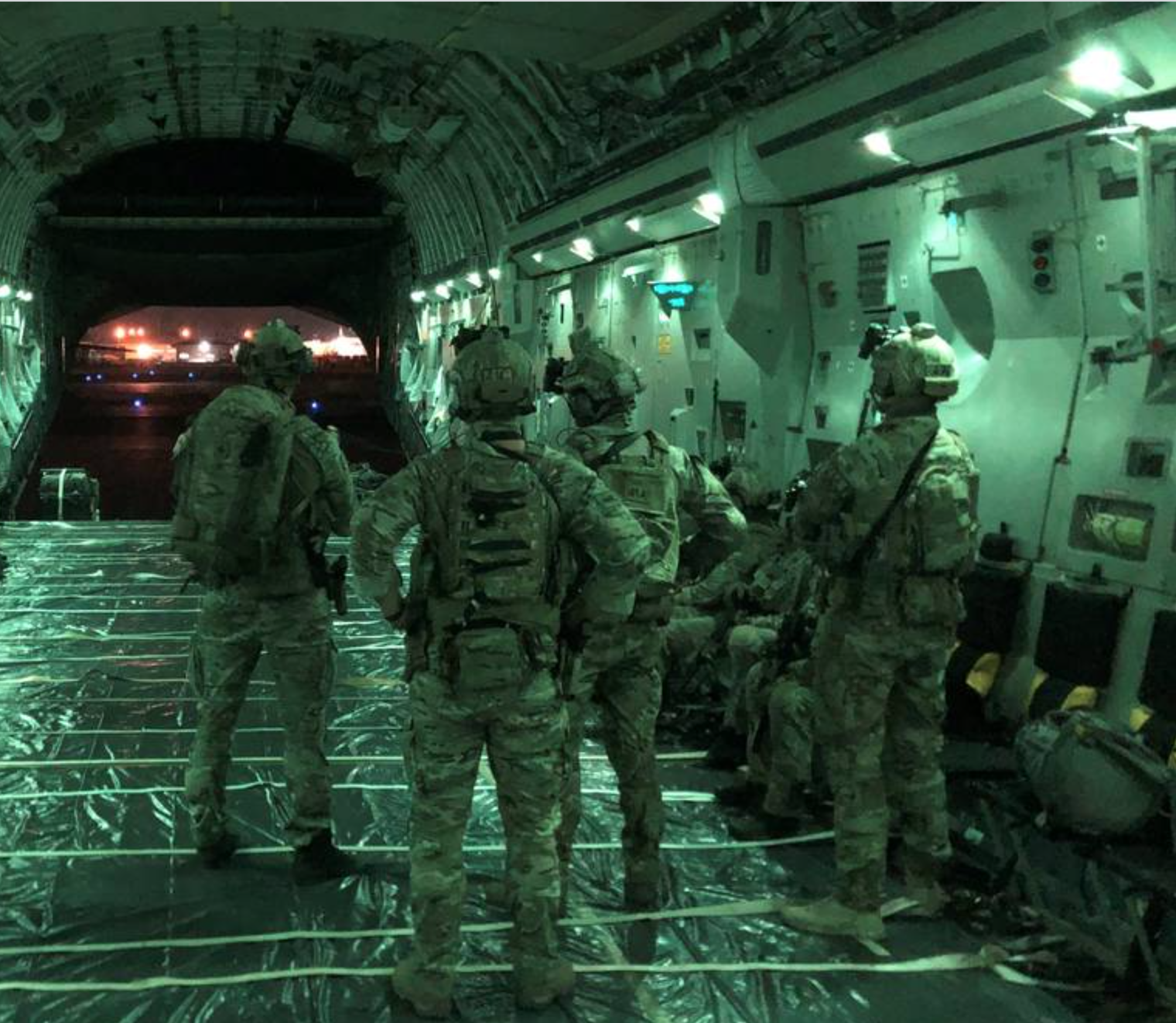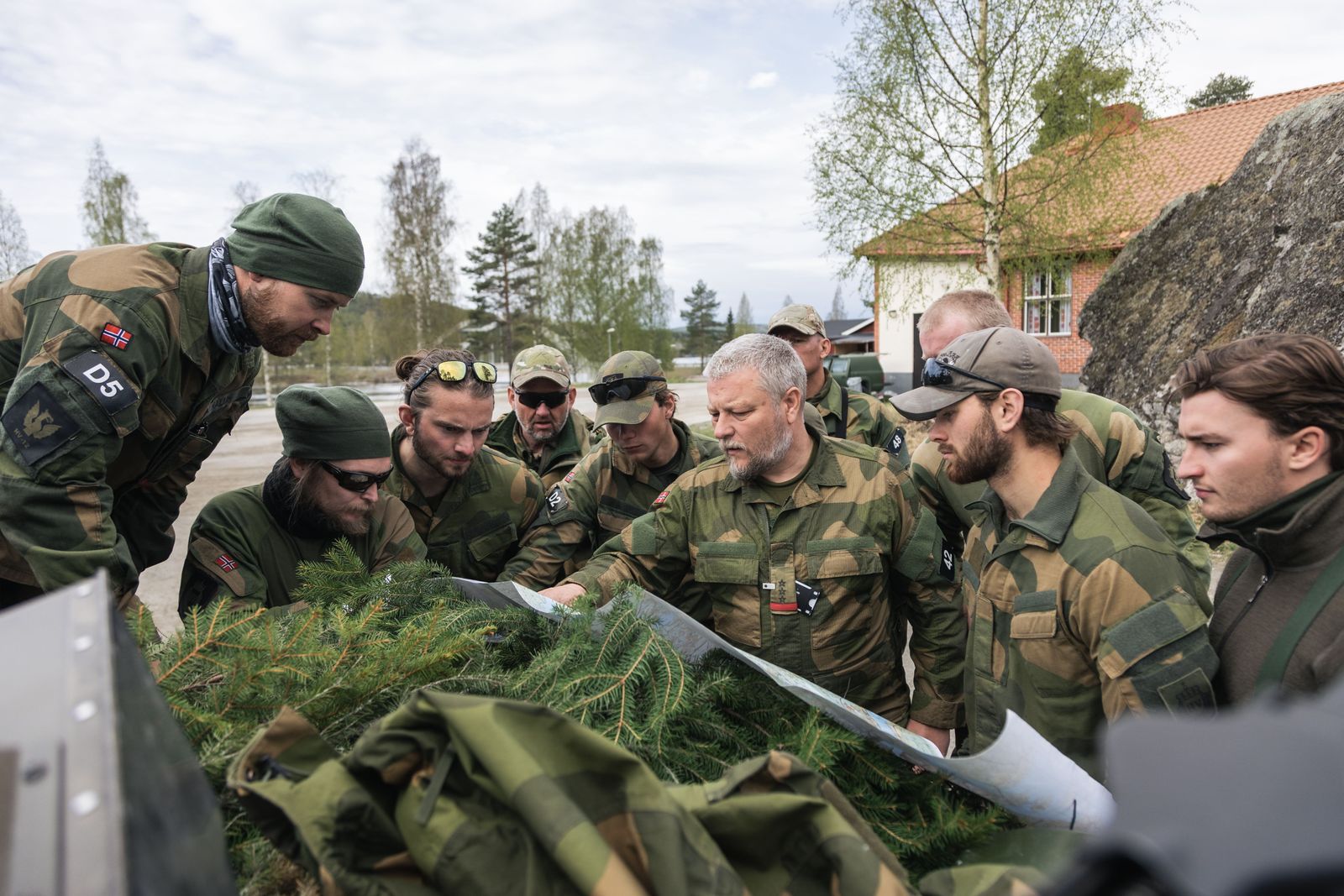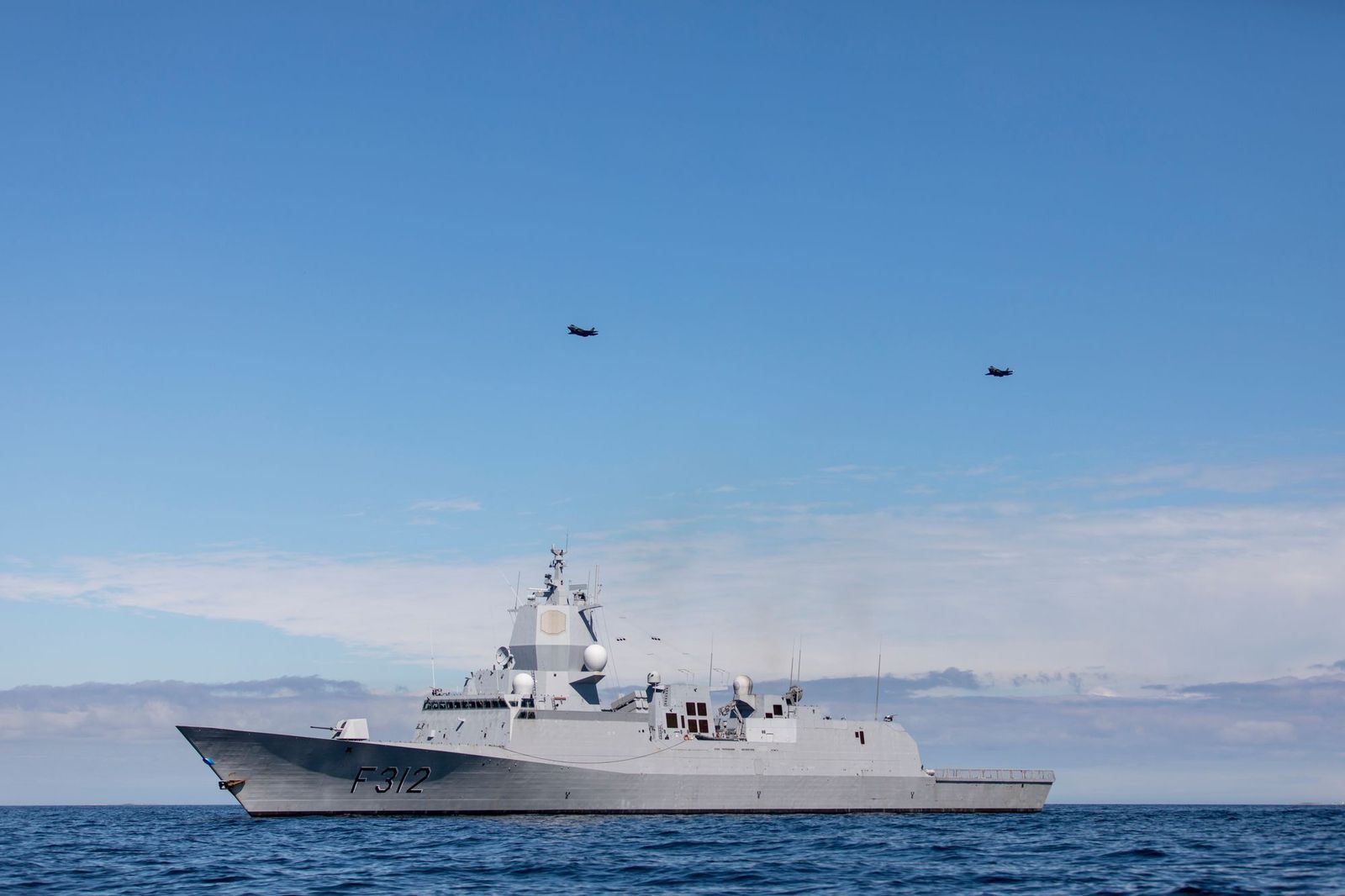This article is written to articulate the general knowledge needed to gain a general understanding of special operations for everyone serving at the joint operational level. The first section of the article illustrates the importance of knowledge at the operational level. The second section briefly explains the core elements of special operations. Finally, the article provides a basic understanding of applicability of special operations. All in all, the essence of special operations.
The apex god of Northern Mythology Odin sacrificed his right eye in exchange for access to the well of wisdom. Yet, this was not enough for him to become all-knowing. He hung himself half-dead from Yggdrasil, the tree of life, where he pierced his own flesh with a spear. After nine nights of torture, he had sacrificed enough, and endured enough pain, to gain all knowledge.[1] This myth illustrates how the path to becoming all-knowing requires sacrifice beyond human capability. From a humble human perspective, it is therefore necessary to prioritize what you want to learn, and which knowledge to keep. The need for prioritizing and evenly distributing knowledge becomes even greater in complex warfare systems like the joint force commands (JFCs). Ideally, everyone should have general knowledge of all areas of joint operations, and it is reasonable to think that general perception of special operations is at an unfavourable low level,[2] which can "inhibit sound planning and operations".[3]
During a Joint Warfare Centre (JWC) directed exercise, an officer described his own prejudice in a VTC by saying: "I guess it's my bias against special operations forces (SOF), but I thought you guys just wanted to kill them all." This kind of prejudice is not a fault of the officer, but a symptom of a greater problem for the special operations community. A combination of prudent operational security that creates mystery on the one hand, and the glorification of the action representing only a small percentage of the special operations portfolio by Hollywood and authors, on the other hand, are to blame.[4] An additional reputational challenge is created by the acts conducted by a very few "bad apples".[5][6] This is why it is so important that the special operations community itself actively works towards informing general purpose forces and counter the misleading Hollywood narrative and occasional bad publicity.
There is a myriad of perspectives, descriptions, and definitions of special operations. Not all are of equal quality, precision, or, more importantly, relevance for all joint officers. They do share several general commonalities that make up a relevant core for a satisfactory understanding of special operations. For brevity of this article, I will only list the following: distinction from conventional operations, the scope and level of risk, and operational and strategic effects.
Distinction from Conventional Forces
Historically, SOF, as we know it today, is relatively new, but the phenomenon of special operations has probably existed for ages. Stories, such as that of the Trojan Horse can be described as a "special operation" at its time.[7] During the 20th century, special operations cemented themselves as a distinct form of warfare apart from the traditional land, maritime, and air operations.[8][9][10][11][12] It is important to see special operations in its historical context as it has evolved both in terms of tasks and missions. In other words, what constituted special operations once may now be considered conventional.[13] During this evolution, one factor has remained more or less the same: special operations have been used to solve missions that conventional forces were either not able to; or, not able to solve with an acceptable level of risk.[14] [15] [16] Special operations are therefore conducted independently, or as a supplement to conventional operations, in a comprehensive joint operations campaign.[17] Understanding the limits of conventional operations is a prerequisite to fully understand and appreciate the utility of special operations. Generally, if the mission can be solved by conventional forces, conventional forces should be used. There is little desire within SOF to be "conventionalized", and thereby lose their core characteristics.[18]If conventionalized, SOF could become redundant on the basis of not having the required manning, being specialized enough, or able to match conventional forces in conducting conventional operations. Special operations are different compared to the conventional operations, where the latter tend to be more specialized.[19]
A relevant but simple example can be drawn from a recent JWC-directed exercise. Based on the fictitious scenario, a weapons system that posed a threat to NATO's air superiority was transported in the joint operations area. During a VTC with the joint force command leadership and the component commands, the situation was discussed. Upon hearing the conversation, the special operations component command took the initiative to assess if there could be a special operations solution to the problem. Preferably, the joint force command should promptly have addressed the special operations component command and tasked them to assess if SOF could solve the problem when a conventional component could not. In this case, a special operations component command initiated partnered-joint special operations, supported by the maritime component command, neutralized the threat, gained valuable intelligence, and enabled host nation forces to arrest smugglers that could be exploited in the exercise information environment.

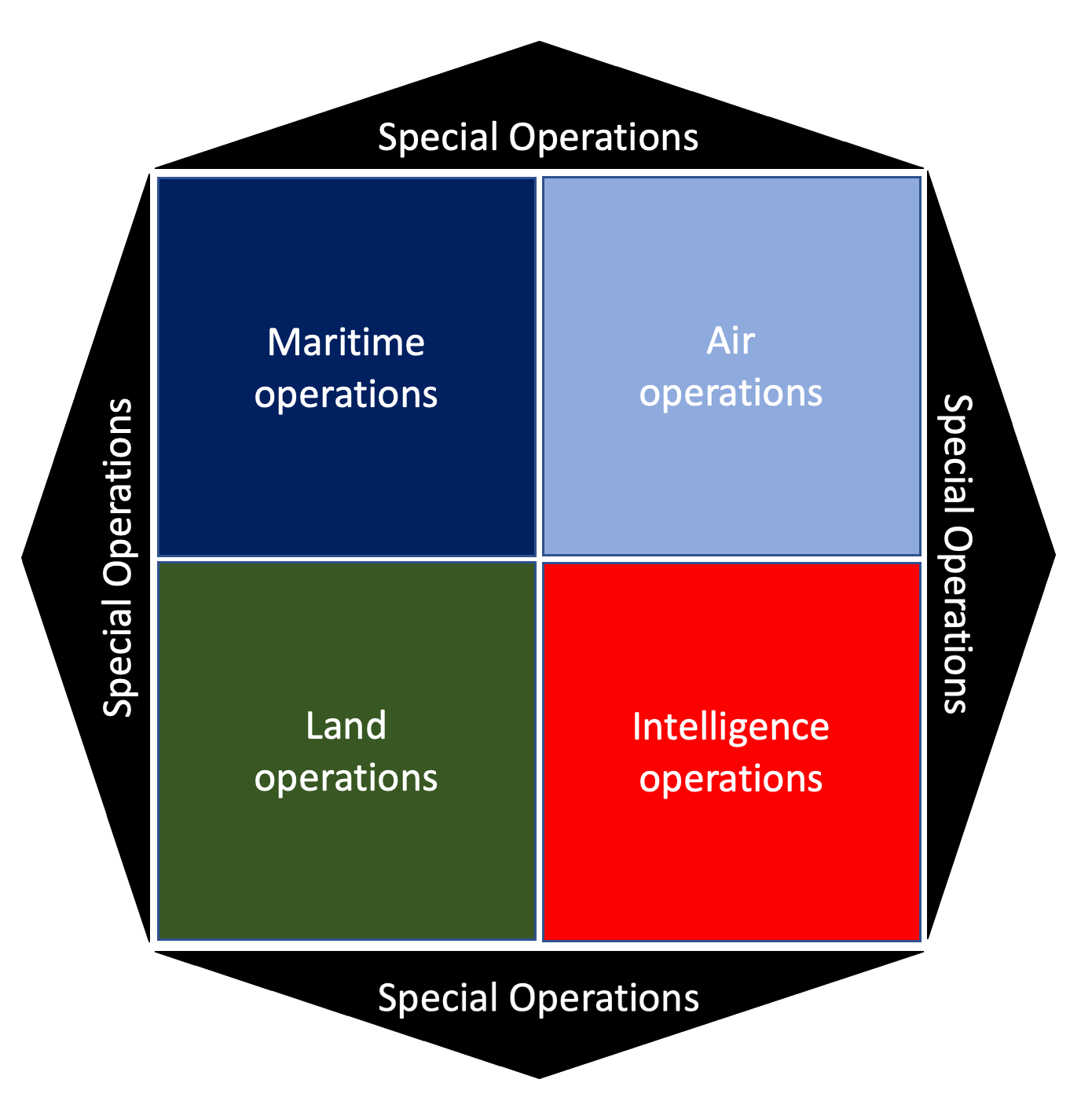
ABOVE: Enhanced joint operational reach. The reach of each field of operations is illustrated by the coverage of its depicted area. The areas for special operations are used to illustrate how they can contribute to potentially increase the operational reach of joint force commands by building on the other fields of operations, and thereby generating complementary effects. (Graphic is authors' own)
SOF complement the conventional forces as an agile, creative force multiplier that are not as affected by, or that to some extent can overcome or circumvent, the main challenges faced by large conventional forces, such as the Clausewitzian concept of the friction of war.[20] [21]
The Scope and Level of Risk
Risk is a key component in considering if a special operation is warranted or not. When assessing risk related to military activities one must always analyse the possible outcomes, that is, weighting the desired achievements against the severities of potential adverse consequences given the associated uncertainties. If the stakes are high, in that the potential adverse consequences can have operational, strategic, or political impact, special operations might be the only acceptable option. This is particularly the case if the severity of the potential impact will be difficult, or impossible to mitigate. Special operations have comparative advantages related to risk mitigation.[22] Factors of risk mitigation exclusive to special operations include the following five examples:
- A favourable ratio of support and enabling personnel to the ground forces: It is not uncommon for 30 special forces operators "on the ground" to be supported by more than a hundred dedicated personnel on the tactical level alone. A considerable part of this support is to enable cross service cooperation in order to achieve joint effort.[23] [24]
- Pre-emptive effort in selection/training of SOF operators and support personnel: The selection process of SOF operators is generally very demanding, in order to meet some of the highest standards in the military. The same goes for the following education and day-to-day training. For support personnel, the requirements vary specific to the functional areas, but are generally very thorough.[25]
- Relative superiority: Admiral William McRavens' theory of special operations explains how small SOF teams, given the right circumstances, can compensate for, and, to some extent, overcome many of the challenges conventional forces are burdened with through the concept of relative superiority.[26]
- Strict operational security: Many special operations are executed with a narrow margin of error. Operational security can be paramount in order to enable and maintain the desired outcomes of special operations.[27]This is one of the reasons why SOF can be perceived to "out loop" standardized staff processes by gaining access to the commanders outside of the regular chain of command.
- Unconventional creativity: In theory, every special operation is unique, or at least, it can be conducted in a unique manner. SOF operators are, amongst other things, selected based on their problem-solving skills. SOF culture fosters and appreciates creativity in a bottom-up driven planning process. Thus, combined with SOF's training in unconventional techniques, procedures and methods, special operations are inherently unpredictable for an opponent.[28]

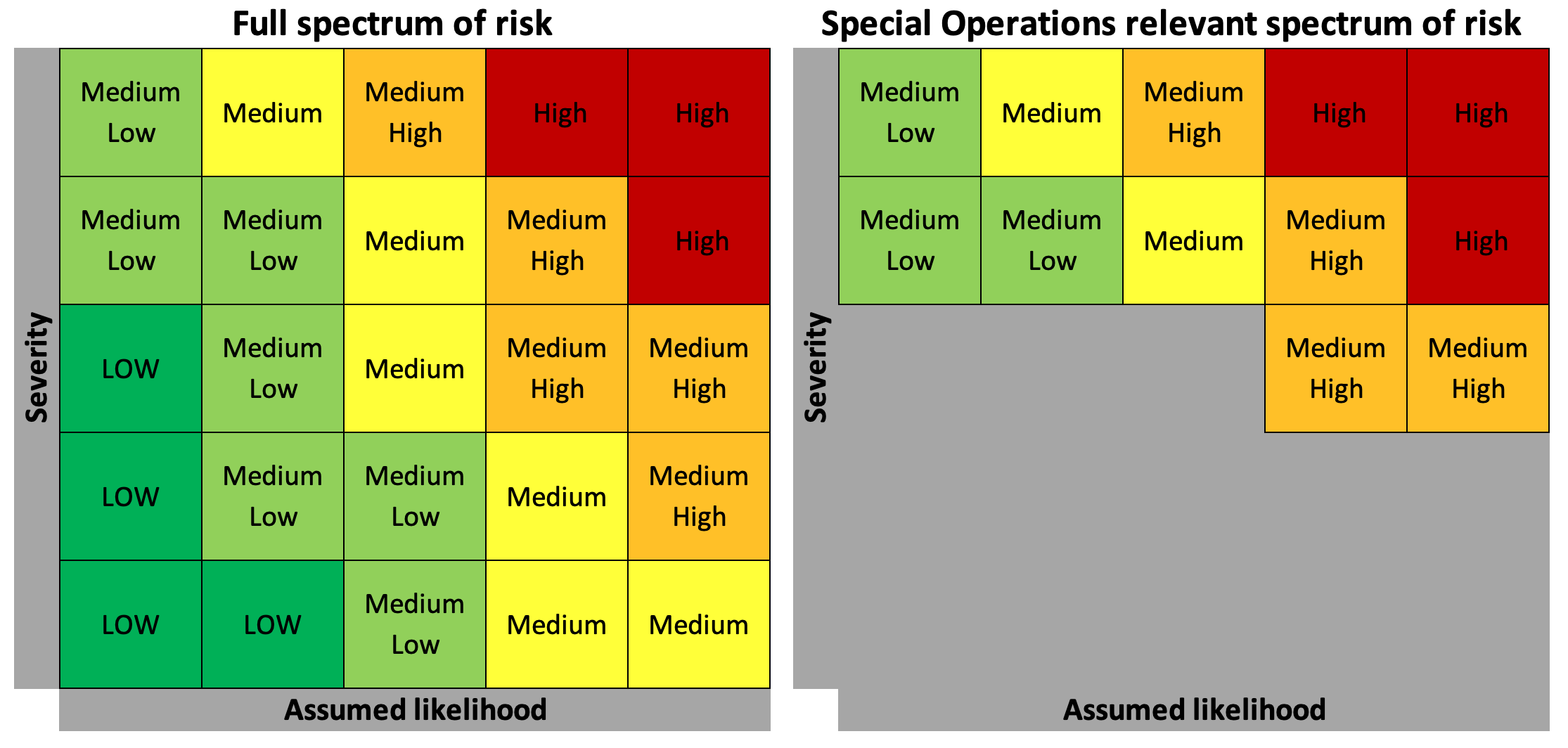
Operational and Strategic Effects
As previously noted, special operations represent an alternative, or a supplement, to conventional operations. The decision makers that choose between conventional and special operations are serving at the operational level or higher. This has contributed to shaping SOF, as their development and ambitions are heavily influenced by the operational and strategic levels of war. SOF operate in small teams and, unlike conventional forces, are not suited for enduring or large-scale combat engagements. They are, however, suitable for kinetic strikes with precise use of lethal forces in order to reduce the potential of collateral damage, and alternatively, for non-kinetic covert operations over longer periods of time. Combined with the aforementioned ability to mitigate risk, special operations remain viable options for operational and strategic decision makers and are particularly suited for high-risk missions that do not require the volume and certain specialized warfighting capabilities that only conventional forces can provide.
History has proven a few particularly valuable lessons when it comes to conducting special operations and generating the ability to do so. Attempting to generate forces capable of conducting special operations as the need arises have proven to be challenging at best. [29]There are several examples where the hasty establishment of SOF have resulted in significant shortfalls.[30]Additionally, conventional leaders given command over SOF have struggled to utilize them effectively. Misuse of SOF has cost lives, and in certain examples, almost eradicated whole SOF units on the battlefield.[31]
This illustrates two distinct lessons. Limited resources must be utilized where they can provide the biggest payoff. For this reason, special operations should be aimed towards operational and strategic goals and effects. The force generation and application of most special operations require strategic patience and early implementation in order to reach its full potential. This is partly the reason why the United States created its Joint Special Operations Command, and NATO members, like Denmark and Norway, have extracted their SOF units from their respective services and placed them under a joint leadership.[32][33][34]Additionally, this requires direction and prioritization from senior leadership. For this reason, special operations should be aimed towards operational and strategic goals and effects. Linking the small-scale tactical actions of SOF to desired operational and strategic effects remains the principal challenge for the operational level leadership.
Operation Gunnerside, the Allied sabotage of Nazi Regime's efforts to build an atomic bomb in Norway in 1943,[35]and Operation Neptune Spear, the U.S. raid that killed Osama bin Laden in 2011, demonstrate how special operations can have significant strategic effect.[36][37]Additionally, the examples illustrate how special operations can both solve problems of strategic importance that could not be conducted by conventional forces, and how the following presentations of the operations are skewed towards the action-filled culmination of several special operations towards the same end state. The lesser known, but equally significant, Operation Grouse was a prerequisite for Operation Gunnerside starting five months earlier. Operation Grouse was the collection and analyses of the intelligence that enabled the detailed planning of Gunnerside's raid.[38]Similarly, the extensive work that enabled Neptune Spear has not been given more than a fraction of the attention that has been given to the raid on the Al Qaida compound in Abbottabad, Pakistan. This is creating a limited appreciation for what actually transpired and its complexity. Similarly, the decade-long Trojan War of Greek Mythology for the majority is only known for its Trojan Horse.
The Generic View of Special Operations
Special operations described up to this point retains a level of ambiguity. This can be challenging, as it does not provide a precise understanding. But it is a necessity for special operations not to be limited by rigid definitions or perceptions. As mentioned, in theory, the next special operations mission can be unique and require unrestricted creativity in planning and execution. However, one of the more tangible consequences of the last century's evolution is a generally accepted consensus of three principal tasks within the concept of special operations:
I. Direct Action (DA): Kinetic action distinguished by the level of risk, precision and techniques utilized.[39]
II. Special Reconnaissance (SR): Creating a state of relative certainty from operations conducted in a hostile, contested, or denied environment with potentially political or diplomatic sensitivities.[40] [41]
III. Military Assistance (MA): Potentially several types of support provided to a broad spectrum of local recipients. Ranging from sub-tactical units to national leadership.[42]
There is also a group of additional tasks, such as counter insurgency, counter terrorism, and hostage release operations to mention a few.[43]For elaborations of these tasks NATO's Allied Joint Doctrine for Special Operations provide a good overview for NATO personnel.
That being said, special operations are defined and articulated differently by "big nations", "small nations", and in NATO. Where the U.S. divide special operations into 12 core tasks, smaller countries, and NATO divide special operations into three areas.[44] [45] Generally speaking, special operations is perceived beyond the scope of NATO on national level, while the "big nations" also tend to have a larger and more specialized SOF arsenal.[46] A notable difference is the U.S. Army Special Forces' concept of unconventional warfare, which is long-term, high risk, and low footprint operations conducted in a denied area in order to serve a long-term strategic goal that opposes a local government or occupying power.[47] [48] However, at the operational level, it is beneficial not to exclusively focus on the tactical nature of these tasks, but rather to see them as how special operations give operational or strategic effects.
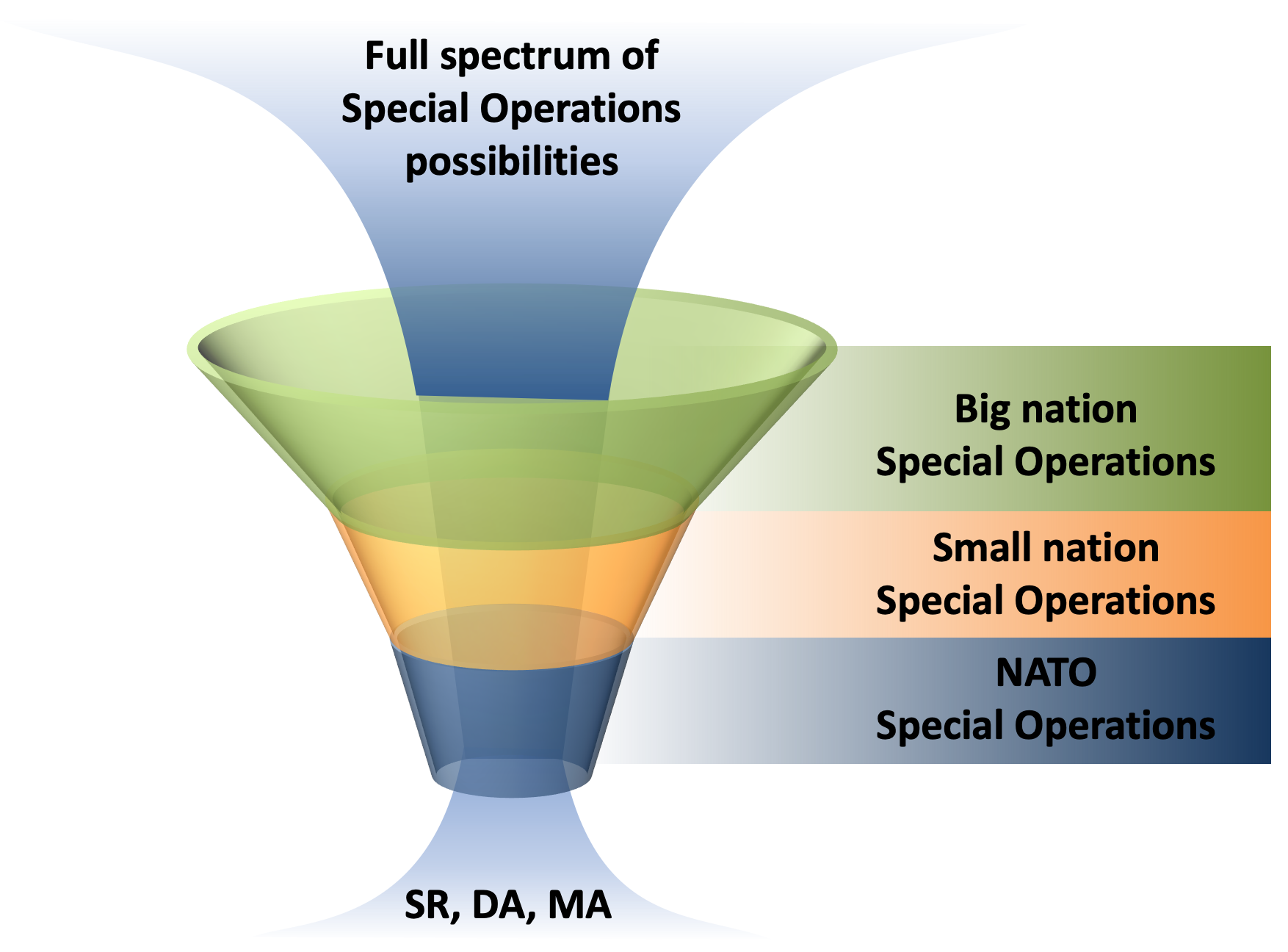

Conclusion
For personnel at the operational level that do not have basic knowledge of special operations, dealing with them can feel as ominous as having to deal with Mjølner, the god wielded weapon of Thor from Norse mythology. It is even more challenging for the operational level leadership whom themselves, as mere mortals, will have to wield such potent and ambiguous powers with a demanding level of precision. In order to pierce through bias and mythology, sober knowledge is key. The more one can expect to interact with special operations, the more crucial the level of knowledge becomes. This is especially applicable for operational and strategic level leadership. This article contains an extensive reference list to provide the curious and motivated readers with detailed information from authoritative and valid sources in order to further develop their knowledge of special operations. For NATO personnel, the natural starting point is NATO's Allied Joint Doctrine for Special Operations. In closing, the general perception of special operations suffers from unclassified sources that present historical examples, and the skewed "Hollywood narrative", which creates a simplified and less than representative impression. Many relevant special operations are still classified and thereby remain hidden from general military perception. Special operations are not in competition with, but an agile supplement to, the capabilities of within conventional operations. Special operations forces do not intend to, and most often are not able to, take the missions conventional forces can conduct themselves.
Foto: Soldatar fra Forsvarets spesialkommando i ett C-17 transportfly på Kabul flyplass under evakueringen (Politiet)
This article was first published in NATO JWCs Three Swords Magazine
References
- NATO - Allied Joint Doctrine for Special Operations.
- McRaven, SPEC OPS: Case Studies in Special Operations Warfare: In theory and practice.
- Searle - Outside the Box: A New General Theory of Special Operations.
- Lamb & Tucker - United States Special Operations Forces – Second Edition.
[1] Northern Mythology: https://www.norron-mytologi.info/gudene/odin.htm
[2] Jensen, Lars H. E. (2014). Special Operations —Myth and Facts. København: Royal Danish Defence Collage Publishing House3 Collins, John M. (1986). United States and Soviet Special Operations Study. Michigan: University of Michigan Library
[3] Collins, John M. (1986). United States and Soviet Special Operations Study. Michigan: University of Michigan Library
[4] Jensen, Lars H.E.
[5] Knaus, Christopher. (2020). Australian Special Forces involved in murder of 39 Afghan civilians, war crime report alleges. The Guardian: https://www.theguardian.com/australia-news/2020/nov/19/australianspecial-forces-involved-in-of-39-afghan-civilians-warcrimes-report-alleges
[6] Associated Press. (2019). A look at the case of Navy Seal Eddie Gallagher. Associated Press: https://apnews.com/article/7371d4bfbb5348acb6727ad48acbcad8
[7] Ljøterud, Ståle. (2012). Spesialoperasjoner med kløkt og mot (Special Operations with smartness and Courage). In "Krigens Vitenskap en introduksjon I militærteori" (The Science of War an Introduction to Military Theory) Oslo: Abstrakt Forlag
[8] Moyar, Mark. (2017). Oppose Any Foe —The Rise ofAmerica's Special Operation Forces. Basic Books
[9] Melien, Tor Jørgen. (2012). Våre hemmelige soldater — Norske spesialstyrker 1940-2012 (Our Secret Soldiers — Norwegian Special Operations Forces 1940–2012) Oslo: Spartacus Forlag.
[10] Lamb, Christopher J. & David Tucker (2007). United States Special Operations Forces — Second Edition.New York: Columbia University Press.
[11] Ljøterud, Ståle.
[12] Marquis, Susan L. (1997). Unconventional Warfare — Rebuilding U.S. Special Operations Forces.Washington DC: The Brookings Institution.
[13] Ljøterud, Ståle.
[14] NATO Standard. (2019). AJP-3,5 — Allied Joint Doctrine for Special Operations—Edition B Version 1.
[15] Spulak, Robert G. (2007). A Theory of Special Operations; The Origin, Qualities and use of SOF. Florida: Joint Special Operations Forces University
[16] Ljøterud, Ståle.
[17] Ljøterud, Ståle & NATO Standard
[18] Mattingsdal, Jostein. (2020). Konvensjonalisering: Spesialstyrkenes største frykt (Conventionalizing: Special Forces' Greatest Fear) Bergen: Stratagem.No https://www.stratagem.no/konvensjonaliseringspesialstyrkenes-storste-frykt/
[19] Searle, Tom. (2017). Outside the Box: A New General Theory of Special Operations. Tampa: Joint Special Operations University.
[20] McRaven, William. (1995). Spec Ops: Case Studies in Special Operations Warfare: In Theory and Practice.New York: Ballentine Books.
[21] Spulak, Robert G.
[22] McRaven, William. (1995), Searle, Tom & Robert G- Spulak.
[23] NATO Special Operations Headquarters. (2014). Special Operations Component Command Manual. Belgium: NATO
[24] Collins, John M. & NATO Standard
[25] Colins, John M. Christopher Lamb, Tor Jørgen Melien, Susan L. Marquis, Mark Moyar & Robert G. Spulak.
[26] McRaven, William. (1995).
[27] Collins, John M. & William McRaven (1995).
[28] Ljøterud, Ståle Tom Searle & Robert G. Spulak.
[29] Collins, John M.
[30] Marquis, Susan L. & Moyer, Mark.
[31] Moyar, Mark.
[32] Lamb, Christopher, Susan L. Marquis & Mark Moyar.
[33] Norwegian Lexicon. (2020a). Forsvaret spesialstyrker (Norwegian Defence Forces Special Operations Forces) https://snl.no/Forsvarets_spesialstyrker
[34] Specialoperasjonskommandoen. (2014). Specialoperasjonskommandoen (The Special Operations Command). https://web.archive.org/web/20160304115931/http://forsvaret.dk/HST/Nyt%20og%20Presse/%C3%98vrige%20nyheder/Documents/SOKOM%20FAKTAARK%202015.pdf
[35] Norwegian Lexicon. (2020b). Tungvannaksjonen. (The heavy water raid) Https://snl.no/tungtvannsaksjonen
[36] McRaven, William. (2019). Sea Stories: My life in Special Operations. New York: Grand Central Publishing
[37] Moyer, Mark.
[38] Melien, Tor Jørgen & Norwegian Lexicon (2020b).
[39] Ljøterud, Ståle, NATO Standard, William McRaven and Tom Searle
[40] Westberg, Anders. (2016). To See and Not to Be Seen: Emerging Principles and Theory of Special Reconnaissance and Surveillance Missions for Special Operations Forces, Special Operations Journal, 2:2, 124-134.
[41] Ljøterud, Ståle, NATO Standard
[42] Ljøterud, Ståle, NATO Standard
[43] Ljøterud, Ståle, NATO Standard
[44] Kristiansen, Marius & Andreas Hedenstrøm. (2016). Defense Capstone Project Report: NORSOF Military Assistance Capability Development. Monteray: Naval Postgraduate School.
[45] Ljøterud, Ståle.
[46] Colins, John M. Christopher Lamb, Tor Jørgen Melien & Mark Moyar.
[47] Lamb, Christopher & Tom Searle
[48] U.S. Army Special Operations Command (2016) Unconventional Warfare Pocket Guide Fort Bragg: U.S. Army Special Operations Command.


